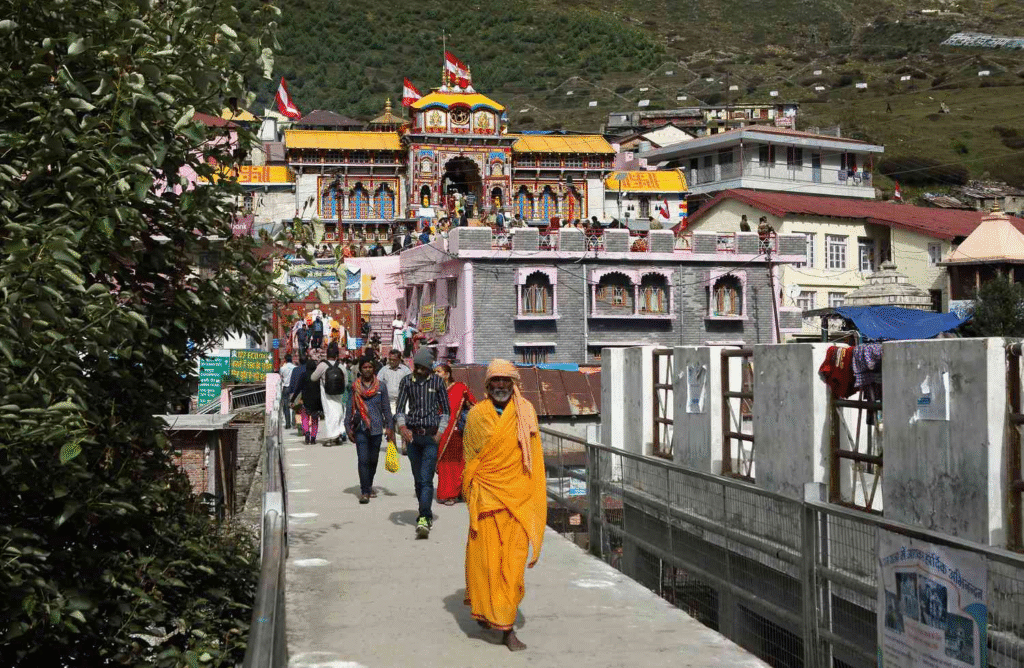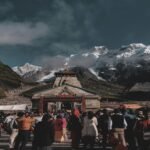
The Badrinath Yatra isn’t a checkmark on a bucket list; it’s a sacred conversation, a road trip where every mile peels back a layer of the ordinary, leading you closer to the extraordinary heart of the divine.
Up here, in the cold, thin air of the Garhwal mountains, faith feels less like doctrine and more like a physical force. This is where Lord Vishnu, the Preserver, sits in deep meditation, shaded by the very mountains. Badrinath is the king of the Char Dhams, the ultimate destination where you seek not just blessings, but Moksha—liberation.
Ready to trade your office chair for a mountain view? Let’s lace up our shoes and discover the divine stories and hidden havens along the most beautiful road in the Himalayas.
The Sacred Overture Badrinath Guide: The Journey Begins
Your journey of surrender starts long before you reach Badrinath town. The traditional spiritual launchpads are Haridwar or Rishikesh.
Haridwar at Dusk: Don’t miss the Ganga Aarti at Har Ki Pauri. It’s more than a ceremony; it’s an emotional flood. Watching thousands of flickering lamps being gently pushed into the dark river is the most beautiful lesson in letting go. That’s your permission slip to leave your worries behind before heading up the hill.
Rishikesh: Think of this as your spiritual stretch. Get up early, find a quiet spot on the Ganga Ghats, and meditate or just watch the river flow. Visit the Beatles Ashram not for the history, but for the silent, artistic peace that still lingers in the crumbling walls. This is where you settle your mind for the long road ahead.
The road itself is a visual pilgrimage. Unlike the climb to Kedarnath, the entire journey to Badrinath is motorable. You’ll hug the Alaknanda River for hours, watching its color shift from gentle jade to furious turquoise. Every turn is a postcard: Devprayag, Rudraprayag, Karnaprayag… they aren’t just names; they’re the Panch Prayag, where mighty rivers merge. Witnessing these confluences is a powerful reminder that all paths, even seemingly disparate ones, eventually flow into the same vast ocean.

Badrinath Temple: The Still Point of the World
Finally, you arrive. Badrinath town is bustling but focused. Above it all, stands the temple, overlooked by the towering, perfect snow cone of Neelkanth Peak.
The story here is tender: The fierce Lord Vishnu chose this spot for penance, but the weather was so harsh that Goddess Lakshmi shaded him, taking the form of the humble Badri tree. It’s a beautiful myth about partnership and sacrifice.
Your Moment of Darshan
The temple itself, brightly painted with a glistening gold spire, feels defiant against the grey rock and white snow. But the true heart is inside. After bathing in the divinely warm waters of the Tapt Kund (a natural hot spring right next to the freezing river—a surreal experience!), you enter the sanctum.
There sits Lord Vishnu (Badri Narayan), not standing, but seated in a deep, meditative posture. This black stone idol—a powerful yogi—instantly demands silence. As the bells ring and the priests chant ancient Sanskrit, you realize the noise of the journey melts away. This is the moment of surrender. You’ve sought him through the mountains, and here he is, asking you to just be still.

Places That Hold the Story: Essential Stops
The Badrinath journey isn’t complete without exploring the incredible sites right around the main town. These places breathe life into the mythology.
1. Mana Village: Where History Was Written
Just 3 km from the Dham is the “Last Indian Village.” Mana is where the modern world ends and mythology begins. It’s an essential, mind-boggling stop.
Vyas Gufa (Cave): Go inside and imagine Sage Vyas seated here, composing the massive epic, the Mahabharata. The energy is palpable—it feels like the birthplace of knowledge.
Ganesh Gufa: Nearby is where Lord Ganesha is said to have transcribed the epic.
Bhim Pul: You’ll see the furious Saraswati River (which is mainly underground, making its visible appearance here so special!) crashing through the valley. This massive natural rock bridge is said to have been placed by Bhima to help the Pandavas cross. It’s a powerful image of strength in service.
2. Tapt Kund & Brahma Kapal: Cleansing the Soul
The Tapt Kund is your Himalayan hot tub—a spiritual rite of passage. Stepping into the deliciously warm, sulphuric water before your Darshan, while the cold wind blows, feels like being embraced by the earth itself.
Right by the river is Brahma Kapal, a sacred spot for performing Pind Daan (ancestral offerings). Whether you participate or just watch, the ritual connects you to history, family, and the flow of generations.
3.Joshimath: The Winter Watcher
On your way up or down, stop at Joshimath. This is the winter seat of Lord Badrinath, and the energy here is ancient. Visit the Narsimha Temple, dedicated to Lord Vishnu’s fierce protective form. It genuinely feels like a fairytale land, a secret garden for the gods.
Hemkund Sahib: Near the Valley of Flowers trek base, this revered Sikh pilgrimage site is a high-altitude lake surrounded by seven snowy peaks. The trek is challenging, but the sight of the still, emerald lake and the serene Gurudwara at 15,000 feet is a spiritual reward that transcends religion.
B. Auli: Views from the Sky
From Joshimath, take the cable car up to Auli. It’s renowned as the “Switzerland of India.” You don’t have to ski; just sit and gaze at the uninterrupted panorama of peaks, including Nanda Devi. It’s a moment of profound peace and incredible visual clarity.
Warm up with steaming cups of ginger tea and maybe a sweet bite of Jhangora Kheer (millet pudding).
Every meal feels earned, and sharing a pot of tea while watching the sun hit the peaks is often the most quietly spiritual part of the trip.
If you don’t want to worry about anything from travel to food you might also contact any tour and travel companies like The Mountain Trekker who will take care of every minute thing and make your journey safe and comfortable.

Leaving Badrinath
As the sun sets behind the massive Neelkanth, and the temple bells fade, you know the truth: you didn’t just visit a place; you returned to a deeper part of yourself.
If you loved reading about the Badrinath Guide you might also like Kedarnath Guide.





Leave a Reply